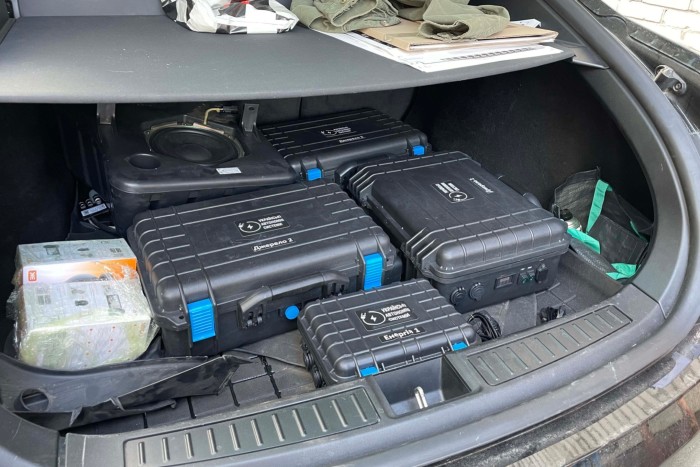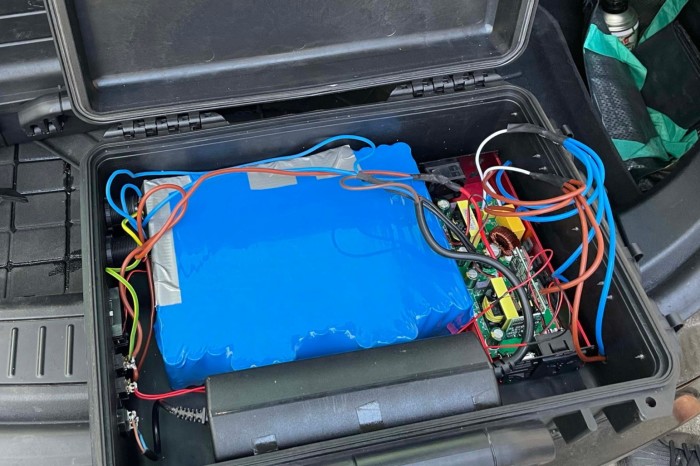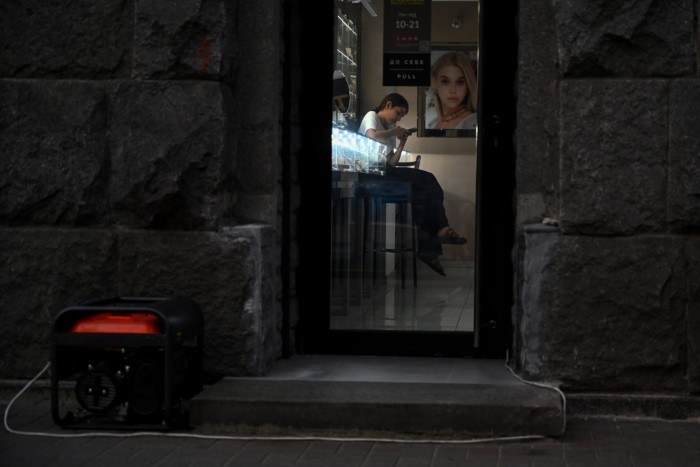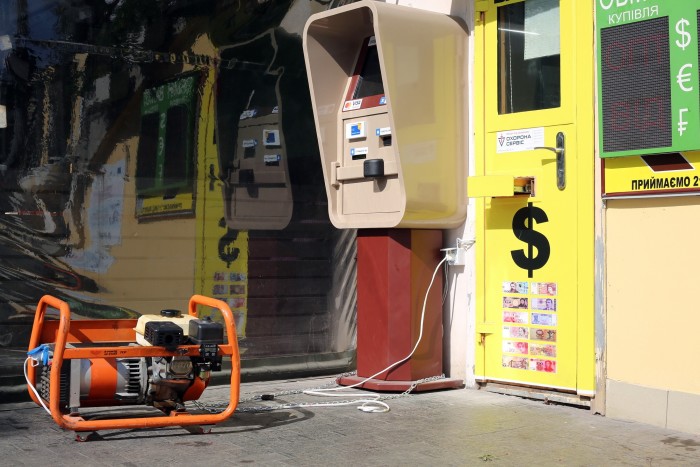
In a tiny garage on the outskirts of Kyiv, a group of mechanics pored over the carcass of a wrecked old Tesla, stripping it of parts. But instead of trying to repair the car, the men were busy extracting its battery, hoping to use it to power local businesses and homes.
Their work — which can turn a single discarded Tesla into a dozen home battery systems — is one of myriad ways in which Ukrainian businesses are responding to the regular blackouts the country has faced since Russia launched a string of attacks on its energy grid earlier this year.
Russia has now knocked out or captured more than half of Ukraine’s domestic electricity generating capacity, forcing energy companies to impose rolling nationwide blackouts that have left homes and businesses without electricity for up to 20 hours a day.
Businesses have been forced to adapt. Across Kyiv, diesel generators parked outside shops and cafés rumble into action as soon as power goes down, and many households in the capital plug their appliances into rechargeable battery systems at home.
Oleksandr Bentsa, 30, realised he had a potential solution to hand. For years, the businessman had been buying crashed Teslas on insurance auctions in the US and importing them to Ukraine, where his mechanics would restore and resell the cars.
When the most severe blackouts began this spring, he realised there was a new use for his trade. Bentsa found electricians capable of doing the dangerous job of carving salvaged Tesla batteries into multiple rechargeable systems.


“An old Tesla, including the cost of delivery, will be nearly $10,000. And you can turn that into 12 batteries, and also sell the parts,” he said. He named his brand Ukrainian Autonomous Systems.
Each system thus produced has a capacity of 5 kilowatt hours, enough to run the lights and electrical equipment — but not energy-hungry electric heating — in a normal Kyiv apartment for 10 hours. Some he sells without a margin to the army, but most of his customers are civilians. Demand has gone from near zero to sky high in the past two months, and Bentsa expects it to rise as winter approaches.
“What we see now is just a little, little, little piece. What we will see in the winter, it will be a very great problem,” Bentsa said.
Ukrainians will face electricity cuts until the war is over, say analysts, with Russian attacks set to continue and the repair effort playing catch-up.
Some key nuclear and thermal units were expected to come back online next month, once repair works are completed, easing the situation to a degree, said Volodymyr Omelchenko, an energy expert at the Razumkov Centre think-tank, and pressure on the grid also eased after a powerful heatwave receded last week.
But repairs will still only bring electricity supply for consumers back up to at least 12 hours a day, and more Russian attacks could inflict further damage.

Nataliia Shapoval, head of the Kyiv School of Economics Institute, said Ukraine and its partners need to grasp the wider Russian strategy: if attacks continue, Ukraine could soon lack power for its capital-intensive large businesses, triggering a fall in tax revenue.
“It will be a really significant problem for our macroeconomic situation,” she said.
Dealing with the energy crisis has pushed up costs for businesses across Ukraine.
Roman Vakulenko, a garage manager, has installed a generator at the shop. “But this means the price of our work goes up, and people start getting upset,” he said. “If previously something cost 800 [hryvnia], it now costs 900” ($22).
For some, the additional energy costs push an already tight business model into the red.
At a 1,000 square metre refrigeration facility in Kyiv, Andriy Aleynik stores some 300 tonnes of frozen food, such as berries and potato chips, at temperatures of -18 to -20 degrees centigrade.

“A café might require 2 kilowatts of energy per hour, but we need 400 kilowatts,” Aleynik said. A generator like that can cost between €70,000 and €150,000. “This is a very big sum. For us to go and buy that, we’d be repaying the loan for, I don’t know, 10 or 20 years.”
The blackouts, which affect Aleynik’s facility for about 12 hours a day, have led to partial melting of frozen goods that shortens their lifespan. “We can see the cherries leaking, for example. In these temperatures, it’s defrosting.”
With the power cuts also interrupting logistics, and customers purchasing less-perishable food because of blackouts at home, Aleynik’s sales have fallen 70 per cent in the past two months. “I don’t what we’ll do,” he said.
Aleynik hopes his business will be added to a list of critically important enterprises that are guaranteed an uninterrupted power supply by Ukraine’s energy companies.
Before the Russian invasion, Ukraine could produce about 55 gigawatts of electricity. That capacity has now dropped below 20GW.
In Kyiv, traffic lights go off when the power is out, and crossings are navigated ad hoc, with pedestrians holding their phone lights up at night so that drivers can see them. Restaurants have developed “blackout menus”, showing which dishes they can cook when the power is out.
“The situation is tough,” said Dmytro Bilotserkovets, a member of the Kyiv city council and adviser to its mayor. Buses increasingly replace electric-powered public transport such as trolley buses and trams during cuts. “The most important thing now is to try as much as possible to stimulate renewables,” he added.
Solar and wind projects are popping up across Ukraine. Hospitals are tiling roofs with solar panels; sheets of solar panels are being installed in small villages that rely on electric power to pump water from wells; the town of Lutsk has fitted solar panels to traffic lights so they keep working when the mains power is off.
For those who live in apartment blocks, often with electric stoves and electric water pumps, blackouts can mean there is no way to cook or wash as well as no elevators. These are daily problems for Vakulenko, the small garage owner, who lives on the 24th floor.
“I have a big dog and I need to walk it. But we have power cuts from 6pm,” he said.
“So I go home and walk up the stairs to the 24th floor, grab my dog, and then we head back down,” he said, showing the step count on his iPhone fitness app. “And then we go back up again . . . It’s tough.”
But everywhere, Ukrainians are finding ways to adapt. Bentsa’s father has gone a step further than his son, and plugged his entire house in the Kyiv suburbs directly into a Tesla parked in the yard. It is a car with a battery capacity of 100kwh. “You can run a whole house on that for a week,” Bentsa said.